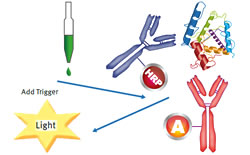Recent News & Events
SPARCL Assays Are a Faster and Less Expensive Way of Doing ELISAs
29
 As a biochemical technique, an enzyme-linked immunosorbent assay mainly detects the presence of an antigen or antibody in a sample. It is used as a diagnostic tool in various industries, including food and health care. However, spatial proximity analyte reagent capture luminescence useful for multiple applications, including enzyme immunoassays, high throughput binding assays, and protein-nucleic acid and protein-protein interactions. The differences between the two assays make SPARCL assays more cost effective and quicker to produce results than ELISAs.
As a biochemical technique, an enzyme-linked immunosorbent assay mainly detects the presence of an antigen or antibody in a sample. It is used as a diagnostic tool in various industries, including food and health care. However, spatial proximity analyte reagent capture luminescence useful for multiple applications, including enzyme immunoassays, high throughput binding assays, and protein-nucleic acid and protein-protein interactions. The differences between the two assays make SPARCL assays more cost effective and quicker to produce results than ELISAs.
What Is SPARCL Technology?
SPARCL technology uses flash chemiluminescence to detect the specific associations or binding interactions of two binding partners. It allows assays to be reduced in size for high throughput examination. The assessment is performed while preserving sensitive results with adequate dynamic range.
The process is different than in enzyme immunoassays. In ELISAs, an antigen is attached to a surface. Next, a specific antibody is added to the surface so that it binds to the antigen. Since the antibody is connected to an enzyme, a substance in the enzyme converts it into a detectable signal. This signal is most commonly a change in color.
In SPARCL assays, the binding partner has a chemiluminescent substrate or acridan. It is brought near a horseradish peroxidase or HRP enzyme through a specific binding event. The close proximity of these binding partners generates a flash of chemiluminescence when an enhancer and a trigger solution that contains hydrogen peroxide are added.
Solid or Solution Phases
You can implement SPARCL technology with a solid or solution phase. A solid phase requires the acridan and a certain capture antibody to be coupled to a solid such as a microparticle or microtiter plate. The solution phase removes the need for the solid, so the capture antibody directly attaches to the acridan compound. Using the solution phase also improves kinetics to reduce incubation time and creates a more natural biological environment. Only a few units of equipment can use this SPARCL technology, such as BMG Labtech's CLARIOstar Microplate Reader.
No Washing Required
However, one of the biggest benefits of SPARCL assays is that there are no washing steps. Most ELISAs require washing steps, which are tedious, time-consuming and require washing stations. SPARCL technology does not require the removal of excess reactants. In fact, it is fine to add a background minimizing agent to reduce the background signal from unbound reactants.
Other Benefits of SPARCL Technology
Along with removing the need for washing steps, SPARCL technology is more cost effective, faster, more flexible and less wasteful than enzyme immunoassays. It is more cost effective because is requires fewer instruments and reagents. There is also no need for bead or plate coating and other automated washing or detection equipment.
Removing the need for washing saves time as well. It is also faster because incubation time is reduced and signal generation is instantaneous. The ability to implement a solid or solution phase makes SPARCL technology more flexible and allows for the study of more targets. Finally, removing the need for washing means that there is no wash solution to discard. ELISAs produce 13 times as much well volume of waste as SPARCL technology. BMG Labtech's CLARIOstar Microplate Reader takes full advantage of these benefits.
